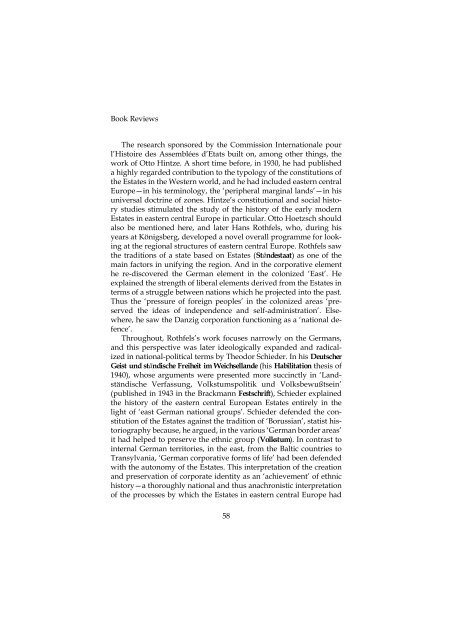Download - German Historical Institute London
Download - German Historical Institute London
Download - German Historical Institute London
You also want an ePaper? Increase the reach of your titles
YUMPU automatically turns print PDFs into web optimized ePapers that Google loves.
Book Reviews<br />
The research sponsored by the Commission Internationale pour<br />
l’Histoire des Assemblées d’Etats built on, among other things, the<br />
work of Otto Hintze. A short time before, in 1930, he had published<br />
a highly regarded contribution to the typology of the constitutions of<br />
the Estates in the Western world, and he had included eastern central<br />
Europe—in his terminology, the ‘peripheral marginal lands’—in his<br />
universal doctrine of zones. Hintze’s constitutional and social history<br />
studies stimulated the study of the history of the early modern<br />
Estates in eastern central Europe in particular. Otto Hoetzsch should<br />
also be mentioned here, and later Hans Rothfels, who, during his<br />
years at Königsberg, developed a novel overall programme for looking<br />
at the regional structures of eastern central Europe. Rothfels saw<br />
the traditions of a state based on Estates (Ständestaat) as one of the<br />
main factors in unifying the region. And in the corporative element<br />
he re-discovered the <strong>German</strong> element in the colonized ‘East’. He<br />
explained the strength of liberal elements derived from the Estates in<br />
terms of a struggle between nations which he projected into the past.<br />
Thus the ‘pressure of foreign peoples’ in the colonized areas ‘preserved<br />
the ideas of independence and self-administration’. Elsewhere,<br />
he saw the Danzig corporation functioning as a ‘national defence’.<br />
Throughout, Rothfels’s work focuses narrowly on the <strong>German</strong>s,<br />
and this perspective was later ideologically expanded and radicalized<br />
in national-political terms by Theodor Schieder. In his Deutscher<br />
Geist und ständische �reiheit im Weichsellande (his Habilitation thesis of<br />
1940), whose arguments were presented more succinctly in ‘Landständische<br />
Verfassung, Volkstumspolitik und Volksbewußtsein’<br />
(published in 1943 in the Brackmann �estschrift), Schieder explained<br />
the history of the eastern central European Estates entirely in the<br />
light of ‘east <strong>German</strong> national groups’. Schieder defended the constitution<br />
of the Estates against the tradition of ‘Borussian’, statist historiography<br />
because, he argued, in the various ‘<strong>German</strong> border areas’<br />
it had helped to preserve the ethnic group (Volkstum). In contrast to<br />
internal <strong>German</strong> territories, in the east, from the Baltic countries to<br />
Transylvania, ‘<strong>German</strong> corporative forms of life’ had been defended<br />
with the autonomy of the Estates. This interpretation of the creation<br />
and preservation of corporate identity as an ‘achievement’ of ethnic<br />
history—a thoroughly national and thus anachronistic interpretation<br />
of the processes by which the Estates in eastern central Europe had<br />
58













